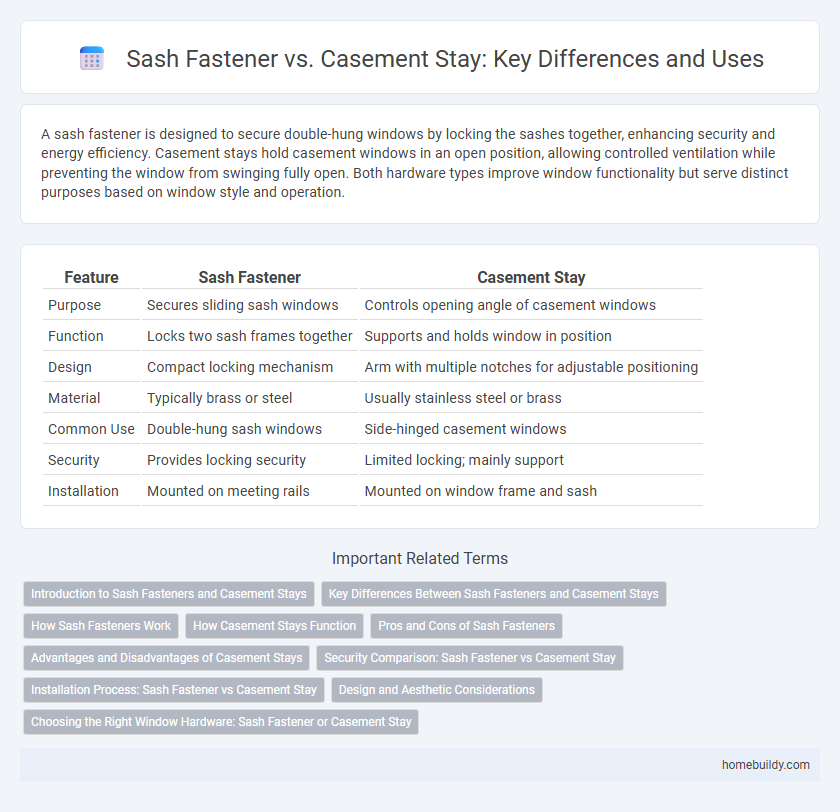A sash fastener is designed to secure double-hung windows by locking the sashes together, enhancing security and energy efficiency. Casement stays hold casement windows in an open position, allowing controlled ventilation while preventing the window from swinging fully open. Both hardware types improve window functionality but serve distinct purposes based on window style and operation.
Table of Comparison
| Feature | Sash Fastener | Casement Stay |
|---|---|---|
| Purpose | Secures sliding sash windows | Controls opening angle of casement windows |
| Function | Locks two sash frames together | Supports and holds window in position |
| Design | Compact locking mechanism | Arm with multiple notches for adjustable positioning |
| Material | Typically brass or steel | Usually stainless steel or brass |
| Common Use | Double-hung sash windows | Side-hinged casement windows |
| Security | Provides locking security | Limited locking; mainly support |
| Installation | Mounted on meeting rails | Mounted on window frame and sash |
Introduction to Sash Fasteners and Casement Stays
Sash fasteners are hardware components designed to secure sliding sash windows, providing smooth operation and enhanced security. Casement stays, on the other hand, are metal bars used to hold casement windows in an open or closed position, offering adjustable ventilation control. Both devices are essential for window functionality but differ in design and application, with sash fasteners tailored for vertical sliding windows and casement stays for hinged windows.
Key Differences Between Sash Fasteners and Casement Stays
Sash fasteners are designed primarily to secure sash windows by locking the sashes together, ensuring tight closure and enhanced security. Casement stays function to hold casement windows at various open positions, providing ventilation control and preventing the window from slamming shut. The key difference lies in their purpose: sash fasteners focus on locking mechanism for window security, while casement stays emphasize adjustable support for window positioning.
How Sash Fasteners Work
Sash fasteners secure sliding windows by locking the sashes together, preventing them from being opened from the outside and enhancing security. Unlike casement stays, which hold casement windows open at various angles, sash fasteners rely on a simple latch mechanism that tightly locks the window sashes in place. Their design focuses on providing a secure seal and ease of operation for traditional sliding windows.
How Casement Stays Function
Casement stays function by locking the window sash in various open positions through an adjustable arm that fits into notches or slots on a fixed plate, providing controlled ventilation and security. Unlike sash fasteners that primarily secure sliding sash windows, casement stays operate on hinged casement windows, allowing precise angle adjustments. The mechanism ensures stability and prevents the sash from swinging freely in windy conditions.
Pros and Cons of Sash Fasteners
Sash fasteners provide a secure locking mechanism for sliding windows, enhancing safety and weather resistance compared to casement stays, which are primarily designed to hold casement windows open. Their compact design and ease of operation offer better aesthetic integration and reduce drafts, but sash fasteners may be less durable under high wind pressure than robust casement stays. While sash fasteners excel in energy efficiency and security for sliding sashes, they might require more frequent maintenance to ensure smooth functionality over time.
Advantages and Disadvantages of Casement Stays
Casement stays provide strong and adjustable support for casement windows, allowing multiple opening positions and enhanced ventilation control. However, they require regular maintenance to prevent corrosion and may limit full window opening compared to sash fasteners, which offer simpler operation and a cleaner aesthetic. While casement stays excel in stability and durability, their bulkier design can affect window appearance and ease of use.
Security Comparison: Sash Fastener vs Casement Stay
Sash fasteners provide enhanced security by firmly locking window sashes together, preventing forced entry more effectively than casement stays, which primarily secure the window in open positions. Casement stays offer limited resistance to external pressure since they mainly function as support arms rather than locking devices. Therefore, sash fasteners are preferred for applications demanding higher security standards.
Installation Process: Sash Fastener vs Casement Stay
The installation process of a sash fastener involves securing the fastener directly onto the sash and frame to ensure tight locking and easy operation, typically requiring precise alignment for optimal security. In contrast, a casement stay is mounted along the window frame with multiple screw points to control the opening angle and provide ventilation, often necessitating careful positioning for smooth movement and stability. While both require drilling and screwing, sash fastener installation emphasizes locking efficiency, whereas casement stay installation focuses on adjustable window positioning.
Design and Aesthetic Considerations
Sash fasteners offer a sleek, minimalist design that complements traditional and modern window styles, providing a subtle yet secure locking mechanism. Casement stays, in contrast, tend to be more prominent and mechanical in appearance, often influencing the window's overall aesthetic with exposed hardware. Choosing between the two hinges on balancing visual appeal with functional design preferences, where sash fasteners prioritize elegance and streamlined looks.
Choosing the Right Window Hardware: Sash Fastener or Casement Stay
Sash fasteners provide secure locking for traditional sash windows, enhancing safety and weatherproofing, while casement stays allow controlled opening for casement windows, offering ventilation and stability. Selecting sash fasteners is ideal for vertical sliding windows requiring tight seals, whereas casement stays suit outward-opening windows prioritizing adjustable airflow. Understanding window type and desired functionality ensures the right hardware choice, maximizing performance and durability.
Sash fastener vs Casement stay Infographic

 homebuildy.com
homebuildy.com